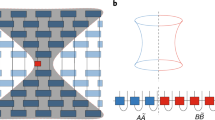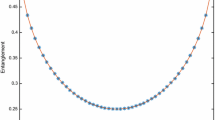Abstract
We study completely separable states of the Lohe tensor model and their asymptotic collective dynamics. Here, the completely separable state means that it is a tensor product of rank-1 tensors. For the generalized Lohe matrix model corresponding to the Lohe tensor model for rank-2 tensors with the same size, we observe that the component rank-1 tensors of the completely separable states satisfy the swarm double sphere model introduced in [Lohe in Physica D 412, 2020]. We also show that the swarm double sphere model can be represented as a gradient system with an analytic potential. Using this gradient flow formulation, we provide the swarm multisphere model on the product of multiple unit spheres with possibly different dimensions, and then we construct a completely separable state of the swarm multisphere model as a tensor product of rank-1 tensors which is a solution of the proposed swarm multisphere model. This concept of separability has been introduced in the theory of quantum information. Finally, we also provide a sufficient framework leading to the complete aggregation of completely separable states.


Similar content being viewed by others
References
Albi, G., Bellomo, N., Fermo, L., Ha, S.-Y., Kim, J., Pareschi, L., Poyato, D., Soler, J.: Vehicular traffic, crowds, and swarms: from kinetic theory and multiscale methods to applications and research perspectives. Math. Models Methods Appl. Sci. 29, 1901–2005 (2019)
Barbǎlat, I.: Systèmes d’équations différentielles d’oscillations non linéaires. Rev. Math. Pures Appl. 4, 267–270 (1959)
Buck, J., Buck, E.: Biology of synchronous flashing of fireflies. Nature 211, 562–564 (1966)
Caponigro, M., Lai, A.C., Piccoli, B.: A nonlinear model of opinion formation on the sphere. Discret. Contin. Dyn. Syst. 35, 4241–4268 (2015)
Carrillo, J.A., Choi, Y.-P., Totzeck, C., Tse, O.: An analytical framework for consensus-based global optimization method. Math. Models Methods Appl. Sci. 28, 1037–1066 (2018)
Carrillo, J. A., Jin, S., Li, L., Zhu, Y.: A consensus-based global optimization method for high dimensional machine learning problems. To appear in ESAIM: Control, Optimisation and Calculus of Variations
Chi, D., Choi, S.-H., Ha, S.-Y.: Emergent behaviors of a holonomic particle system on a sphere. J. Math. Phys. 55, 052703 (2014)
Chandra, S., Girvan, M., Ott, E.: Continuous versus discontinuous transitions in the D-dimensional generalized Kuramoto model: Odd D is different. Phys. Rev. X 9, 011002 (2019)
Chandra, S., Ott, E.: Observing microscopic transitions from macroscopic bursts: instability-mediated resetting in the incoherent regime of the D-dimensional generalized Kuramoto model. Chaos 29, 033124 (2019)
Choi, S.-H., Ha, S.-Y.: Complete entrainment of Lohe oscillators under attractive and repulsive couplings. SIAM J. Appl. Dyn. Syst. 13, 1417–1441 (2014)
Choi, Y.-P., Ha, S.-Y., Li, Z.: Emergent dynamics of the Cucker-Smale flocking model and its variants. Active particles. Vol. 1. Advances in theory, models, and applications, 299–331, Model. Simul. Sci. Eng. Technol., Birkhäuser/Springer, Cham (2017)
Cucker, F., Smale, S.: Emergent behavior in flocks. IEEE Trans. Autom. Control 52, 852–862 (2007)
Danino, T., Mondragon-Palomino, O., Tsimring, L., Hasty, J.: A synchronized quorum of genetic clocks. Nature 463, 326–330 (2010)
DeVille, L.: Synchronization and stability for quantum Kuramoto. J. Stat. Phys. 174, 160–187 (2019)
Frouvelle, A., Liu, J.-G.: Long-time dynamics for a simple aggregation equation on the sphere. Proc. Math. Stat. 282, 457–479 (2019)
Ha, S.-Y., Kim, D., Lee, J., No, S.-E.: Particle and kinetic models for swarming particles on a sphere and stability properties. J. Stat. Phys. 174, 622–655 (2019)
Ha, S.-Y., Ko, D., Park, J., Zhang, X.: Collective synchronization of classical and quantum oscillators. EMS Surv. Math. Sci. 3, 209–267 (2016)
Ha, S.-Y., Ko, D., Ryoo, S.: On the relaxation dynamics of Lohe oscillators on the Riemannian manifold. J. Stat. Phys. 172, 1427–1478 (2018)
Ha, S.-Y., Park, H.: Emergent behaviors of Lohe tensor flocks. J. Stat. Phys. 178, 1268–1292 (2020)
Ha, S.-Y., Park, H.: Emergent behaviors of the generalized Lohe matrix model. To appear in Discrete Contin. Dyn. Syst. B
Hung, S.M., Givigi, S.N.: A q-learning approach to flocking with UAVs in a stochastic environment. IEEE Trans. Cybern. 47, 186–197 (2017)
Kuramoto, Y.: Self-entrainment of a population of coupled non-linear oscillators. In: International symposium on mathematical problems in mathematical physics. Lecture notes in theoretical physics 30, 420–422 (1975)
Lohe, M.A.: Non-Abelian Kuramoto model and synchronization. J. Phys. A 42, 395101 (2009)
Lohe, M.A.: High-dimensional generalizations of the Watanabe–Strogatz transform for vector models of synchronization. J. Phys. A 51, 225101 (2018)
Lohe, M.A.: Systems of matrix Riccati equations, linear fractional transformations, partial integrability and synchronization. J. Math. Phys. 60, 072701 (2019)
Lohe, M.A.: On the double sphere model of synchronization. Physica D. 412, 132642 (2020)
Markdahl, J., Gonçalves, J.:Global convergence properties of a consensus protocol on the \(n\)-sphere. Proc. of the 55th IEEE Conference on Decision and Control (CDC), pp. 2487–2492 (2016)
Markdahl, J., Thunberg, J., Gonçalves, J.: Almost global consensus on the \(n\)-sphere. IEEE Trans. Autom. Control 63, 1664–1675 (2018)
Markdahl, J., Proverbio, D., Gonçalves, J.: Robust synchronization of heterogeneous robot swarms on the sphere. arXiv preprint: arXiv:2004.00296
Nielsen, M.A.: Quantum computation and quantum information. Cambridge University Press, Cambridge (2010)
Olfati-Saber, R.: Swarms on sphere: A programmable swarm with synchronous behaviors like oscillator networks. Proc. of the 45th IEEE Conference on Decision and Control, pp. 5060–5066 (2006)
Perea, L., Elosegui, P., Gomez, G.: Extension of the Cucker–Smale control law to space flight formations. J. Guid. Control 32, 527–537 (2009)
Pikovsky, A., Rosenblum, M., Kurths, J.: Synchronization: A Universal Concept in Nonlinear Sciences. Cambridge University Press, Cambridge (2001)
Vicsek, T., Czirók, A., Ben-Jacob, E., Cohen, I., Shochet, O.: Novel type of phase transition in a system of self-driven particles. Phys. Rev. Lett. 75, 1226–1229 (1995)
Winfree, A.T.: Biological rhythms and the behavior of populations of coupled oscillators. J. Theor. Biol. 16, 15–42 (1967)
Zhu, J.: Synchronization of Kuramoto model in a high-dimensional linear space. Phys. Lett. A 343, 2939–2943 (2013)
Zhu, J., Zhu, J., Qian, C.: On equilibria and consensus of the Lohe model with identical oscillators. SIAM J. Appl. Dyns. Syst. 17, 1716–1741 (2018)
Acknowledgements
The work of S.-Y. Ha is supported by National Research Foundation of Korea (NRF-2020R1A2C3A01003881), the work of H. Park was supported by Basic Science Research Program through the National Research Foundation of Korea (NRF) funded by the Ministry of Education (2019R1I1A1A01059585).
Author information
Authors and Affiliations
Corresponding author
Additional information
Communicated by Irene Giardina.
Publisher's Note
Springer Nature remains neutral with regard to jurisdictional claims in published maps and institutional affiliations.
Rights and permissions
About this article
Cite this article
Ha, SY., Kim, D. & Park, H. On the Completely Separable State for the Lohe Tensor Model. J Stat Phys 183, 9 (2021). https://doi.org/10.1007/s10955-021-02750-0
Received:
Accepted:
Published:
DOI: https://doi.org/10.1007/s10955-021-02750-0
Keywords
- Aggregation
- Completely separable state
- Gradient flow
- Kuramoto model
- Lohe tensor model
- Swarm double sphere model
- Synchronization




